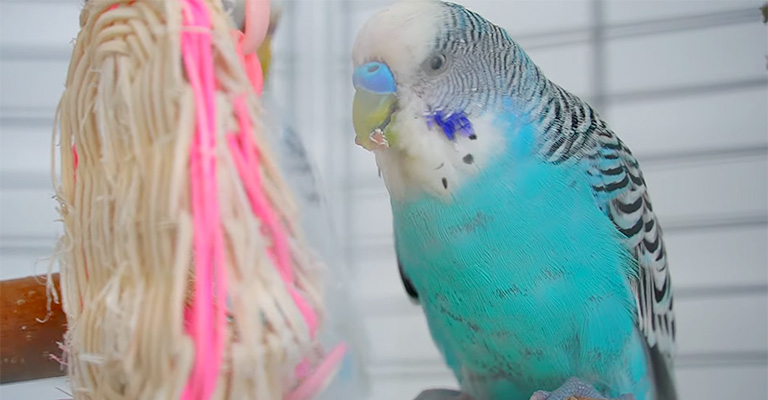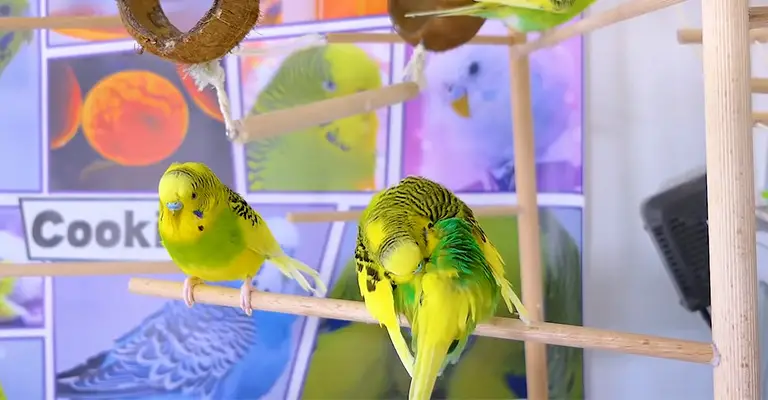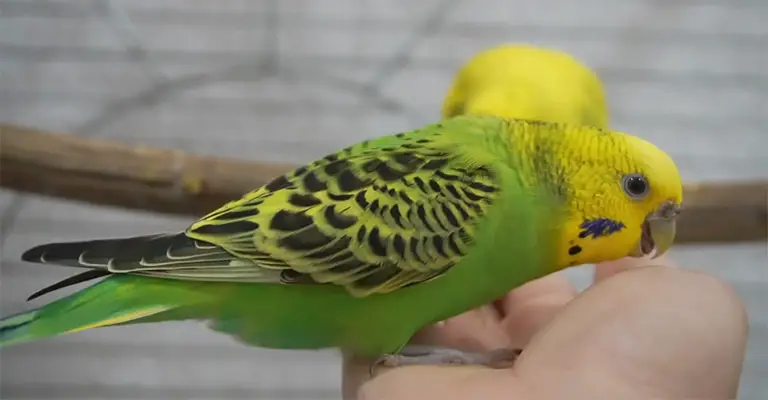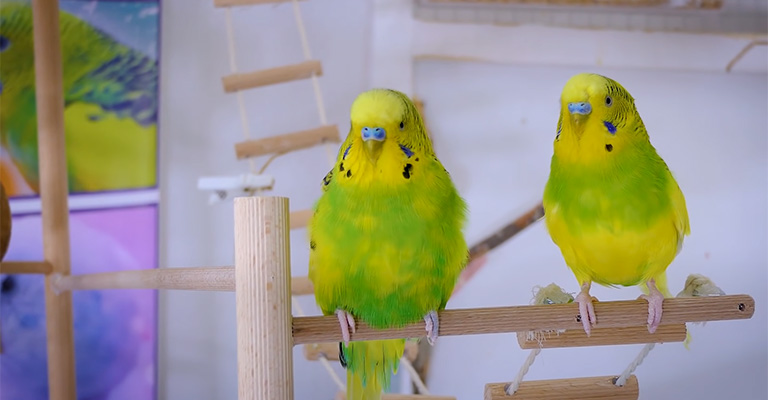Budgies, those charming and vibrant little companions, bring a burst of joy into our lives with their cheerful personalities and vibrant plumage. As responsible pet owners, it’s our privilege and responsibility to ensure our budgies lead content and fulfilling lives.
Creating an environment that caters to their physical, mental, and emotional needs is essential for their happiness. This guide unveils the secrets to how to keep your budgie happy.
From creating an engaging living space filled with interactive toys, and providing a nutritious diet that mimics their natural preferences, to developing a strong bond through social interaction and training, we embark on a journey to explore the multifaceted realm of budgie well-being.
Whether you’re a new budgie parent or an experienced avian enthusiast, these tried-and-true strategies will empower you to nurture a harmonious and joyful companionship with your feathered friend.

How to Keep Your Budgie Happy?
Keeping your budgie happy involves creating a well-rounded and stimulating environment that caters to their physical, mental, and social needs. Here’s how to ensure your feathered friend’s happiness:
Spacious Cage
Provide a spacious cage that allows your budgie to stretch their wings and move around comfortably. Horizontal space is more important than height.
Interactive Toys
Offer a variety of toys that encourage mental stimulation and physical activity. Rotate toys regularly to prevent boredom.
Natural Perches
Include different types of perches, such as wooden and rope perches, to promote foot health and exercise.
Nutritious Diet
Feed a balanced diet of high-quality pellets, fresh vegetables, fruits, and occasional seeds. This mimics their natural diet and ensures proper nutrition.
Social Interaction

Budgies are social creatures. Spend time interacting with your budgie daily through talking, singing, and gentle handling.
Companionship
If possible, consider getting a second budgie for companionship. Budgies thrive in pairs or small groups.
Enriching Activities
Teach your budgie tricks or provide foraging opportunities by hiding treats in toys or around their cage.
Safe Environment
Ensure their living space is safe from potential hazards, such as toxic plants, drafts, and other pets.
Natural Light
Place their cage in an area with natural light, but avoid direct sunlight, which can cause overheating.
Bathing Opportunities
Offer shallow dishes of water for your budgie to bathe in, as many budgies enjoy splashing around.
Quiet Retreat
Provide a quiet corner or hideaway within their cage where they can retreat for some privacy.
Consistent Routine
Stick to a consistent daily routine for feeding, playtime, and sleep to give your budgie a sense of security.
Chirping Buddies
Play recorded budgie sounds or videos of other budgies chirping to give them a sense of companionship.
Positive Reinforcement
Use positive reinforcement training to teach them tricks and behaviors. This mental engagement can be highly satisfying for them.
Regularly visit an avian veterinarian for health check-ups to catch any potential health issues early.
Remember, every budgie has its own personality and preferences. Pay attention to their reactions to different toys, foods, and interactions to tailor their environment to what makes them happiest.
By investing time, effort, and care into your budgie’s well-being, you’ll be rewarded with a joyful and vibrant feathered companion.
Characteristics of a Happy Parakeet

A happy parakeet, scientifically known as Melopsittacus undulatus but commonly referred to as a budgie, is a small and vibrant bird that makes for a delightful companion.
These little birds have a unique set of behaviors and characteristics that can indicate their overall well-being and contentment. Understanding these signs can help you ensure that your feathered friend is leading a happy and healthy life.
Active and Playful
One of the primary indicators of a happy parakeet is its level of activity and playfulness. A content budgie will be lively, hopping around its cage with enthusiasm, and engaging in various playful activities.
These can include climbing on toys, swinging on perches, and even performing acrobatics. A lack of activity or lethargy might suggest that something is amiss, and you should consider consulting a veterinarian.
Vocalizations
Parakeets are known for their melodious chirping and singing. When a parakeet is happy, it tends to vocalize frequently throughout the day. These cheerful vocalizations are often accompanied by head bobs and fluttering wings.
When you approach the cage or interact with your parakeet, it might respond with an increased level of vocalization, indicating its excitement and contentment.
Bright Plumage
The condition of a parakeet’s feathers is a strong indicator of its overall health and happiness. A happy parakeet boasts bright, vibrant, and well-groomed plumage. Regular preening, where the bird uses its beak to clean and arrange its feathers, is a sign of contentment and good health.
On the other hand, if you notice that your parakeet’s feathers appear dull, disheveled, or puffed up, it could be a signal of stress, illness, or discomfort.
Appetite
A happy parakeet has a healthy appetite and readily consumes its food. It eagerly explores and tries new foods as part of its diet.
Social Interaction
Parakeets are social birds. A content parakeet enjoys spending time with you, chirping, flying around, and even perching on your shoulder.
Curiosity
Happiness often comes with curiosity. A happy parakeet will investigate new toys, objects, and changes in its environment.
Playful Behavior
Playing with toys, especially ones that encourage problem-solving or physical activity, indicates a happy and engaged parakeet.
Content Body Language
A parakeet with relaxed body language, such as partially closed eyes, fluffed-up feathers while resting, and a calm demeanor, is likely content.
Clean and Preened Feathers
A happy parakeet takes care of its feathers through preening. It will use its beak to clean and arrange its feathers, which helps in maintaining its health.
Comfortable Sleeping
A parakeet that sleeps soundly and without interruptions during its resting hours is likely to feel secure and content in its environment.
Interactive Behavior
If your parakeet approaches the cage bars when you’re nearby or shows interest in perching on your finger, it’s a sign of trust and companionship.
Playful Interactions
A happy parakeet engages in playful interactions with other parakeets in a shared cage. They might chase each other, share toys, and engage in social grooming.
Balanced Behavior
A happy parakeet displays a balance between active periods of play, vocalization, and exploration, as well as periods of relaxation.
Exploring the Environment
A curious and content parakeet will fly around its cage or designated play area, investigating different perches, toys, and hiding spots.
Remember that each parakeet has its own personality, so the signs of happiness might vary slightly. Pay close attention to your parakeet’s behaviors and body language to understand its unique indicators of contentment.
Providing a safe, enriched, and social environment will greatly contribute to your parakeet’s overall happiness.
What Accessories Can Keep My Budgie Happy?

There are several accessories you can provide to keep your budgie happy and engaged. Here are some options:
Toys
Budgies enjoy ringing and playing with bells. A small mirror can provide entertainment and the illusion of companionship.
Also, swings mimic natural perching and are fun for budgies to sway on. Budgies love tearing and shredding toys made from safe materials like paper or wood.
Perches
Natural wood perches of varying diameters mimic different tree branches and promote foot health.
You can also get rope perches that are soft on their feet and provide a different texture for them to grip. Chewing on cholla cactus perches helps keep their beaks healthy.
Foraging Accessories
Toys that require them to find treats hidden inside stimulate their problem-solving skills. You can give your budgie edible perches that have edible components, providing both entertainment and nutrition.
Puzzle Feeders
Puzzle feeders challenge your budgie to figure out how to access their food, keeping them mentally active.
Bird Baths, Ladders
Providing a shallow dish of water can encourage bathing, which many budgies enjoy. Climbing ladders provide exercise and a different way to explore their cage.
Play Gyms, Hideouts and Nesting Boxes
Play gyms placed outside the cage offer an expanded area for exploration and exercise. Hideouts and nesting boxes provide a sense of security and space for privacy if they want to hide or rest.
Music and Chirping Sounds, Training Accessories
Playing recorded budgie sounds or soft music can mimic the sounds of their natural environment. Clickers and target sticks are useful for training, keeping them mentally stimulated.
Bungee Toys
These toys hang from the cage and provide a unique way to play and exercise. Remember to regularly rotate and introduce new accessories to prevent boredom.
Observe your budgie’s reactions to different items to see which ones they enjoy the most. Creating a dynamic and enriched environment is key to keeping your budgie happy and mentally stimulated.
FAQs
Not all toys are suitable for budgies. Avoid toys with small parts that could be ingested, sharp edges, or toxic materials.
Stick to toys specifically designed for birds and made from safe, bird-friendly materials.
It’s a good idea to rotate your budgie’s toys every few weeks. This helps prevent boredom and keeps their environment fresh and interesting. However, keep one or two familiar toys that they love as a source of comfort.
Yes, you can make homemade toys using safe materials like untreated wood, bird-safe ropes, and natural fibers. Be sure to avoid using anything that could be harmful if ingested, such as glue or toxic paint.
If your budgie interacts with a toy by chewing, swinging, or playing with it, these are positive signs. Vocalizing while near the toy or perching on it also indicates their interest.
Yes, offering a variety of accessories is beneficial. Different toys engage different senses and provide various forms of mental and physical stimulation.
A mix of perches, toys, foraging items, and comfort accessories can contribute to your budgie’s overall well-being.
Conclusion
The happiness of your budgie is not only a reflection of its vibrant plumage but also a testament to the love and care you provide. By implementing the insights shared in this guide, you’re forging a bond that transcends the cage and enriches both of your lives.
Remember, each budgie is unique, with distinct preferences and quirks. The key lies in observation, patience, and flexibility.
Whether it’s introducing new toys, offering a variety of healthy foods, or engaging in interactive play and training sessions, your commitment to their well-being will resonate in their joyful chirps and curious antics.
As you navigate the path of budgie care, keep in mind that your attention, affection, and dedication play a pivotal role in shaping their happiness.
By fostering an environment filled with love, mental stimulation, and opportunities for exploration, you’ll create a sanctuary where your budgie thrives and flourishes.